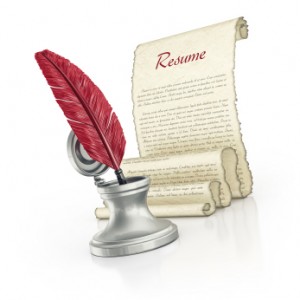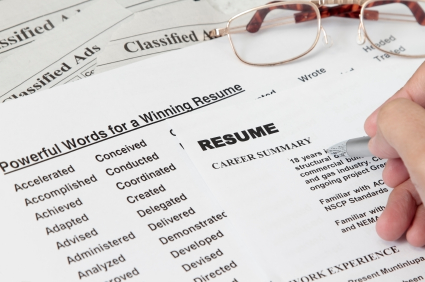
Everyone starts their career in an entry level position. A basic resume is great for entry level positions but will not work for executive positions as your experience grows.
And, experience does grow. There is a young lady who started out as a cashier in a motorcycle accessory store. She did not have a college education and so she didn’t make much money. But she stayed there, went above and beyond the scope of her job and got raises and more responsibility.
After a couple of years, she moved on. This time, it was still a customer service job, but it paid more and it gave her the freedom to go to school to get a degree.
She has since gotten her degree after 3 years and in this current position she just got a promotion to manage two of the stores. It can be done. Many people work hard to climb this ladder of success. But you then have to change your resume to reflect you now, not the you from several years ago.
It’s important to keep your entry level resume up to date. As you progress in the job field, keep adding new skills, new responsibilities, etc. You will also need to adjust your career outlook so that it reflects your work ethic and beliefs and how you can better a company with your experience.
As your resume turns into an executive resume, you will be able to recognize more things you can add to the resume so that it is tailored correctly, tastefully and will encompass everything you know. After all, if a resume is a reflection of you, don’t you want to be presented in the best possible light?
Start The New Year With A New Resume
Executive ResumesProfessional ResumesResume KeywordsResume WritingResumes
Since the new year is here and everyone is making new year’s resolutions, now is the perfect time to start the new year with a new executive resume. Make one of your resolutions a vow to find the perfect job with the right resume.
If you are currently struggling to find a really good job or any job at all, it may be that you need to polish your resume. In this instance, the phrase “if it isn’t broke, don’t fix it” doesn’t work. If it’s hard to find a job, you have to fix something. That something may be your resume. Perhaps you have not listed enough skills or it’s not powerful enough to get someone’s attention.
With as many people out of work in today’s market, it is important that your resume be above par. It may now be time to hire the services of a professional resume writer. Someone who knows just how to make your executive resume stand above the rest.
Our writers will meet with you to discuss what may be working and what might be hindering you on your resume. We’ll also discuss the type of role you are seeking and what you bring to the table. We can then put together a resume that you will be extremely proud of and know that it was well worth the expense of having it professionally done.
So make it your new year’s resolution to clean your resume up so that you will have that dream job in 2012.
How Much Information Is Too Much To Include In A Resume
Executive ResumesProfessional ResumesResume WritingResumes
Resumes have been used for many years now. Some businesses want a resume in addition to a completed application. And, if you have been in the job market a long time, chances are your resume could easily become 10-12 pages. And that, my friends is too long.
Several years ago, when resumes first began, potential interviewers wanted to see what was on a job application but in paragraph form. So, it came to pass that resumes ended up with a lot of personal information that employers today could care less about. In addition to that, the identity theft issue has raised many concerns about personal information that is freely given.
In today’s world of resumes, less is more. It will depend on the type of job you are seeking. College graduates and entry level positions are not going to have much to put on a resume so one page usually suffices.
For executive level positions, resumes could be as long as four pages. The information on executive resumes needs to encompass all the past years’ experience in a management position. Some individuals in this capacity still may not need more than two pages as they might have been with one or two companies for several years. But it will be debatable if even this will work.
For those seeking an executive position, it is important to not only list experience, but employers are going to want to know other things such as problem solving skills, hiring/firing skills, management style and education.
Since the job market is so tough today, it’s very important to fatten your resume so you will stand out from the rest. At the same time, some information does not need to be included. Things like hobbies, interests and family do not need to be on an executive resume. If the employer wants to know these things, it will be asked during a face-to-face interview. Additionally, it is acceptable to put your phone number and city and state. You no longer have to put your address or website on a resume because of the increase in identity theft.
It is also important to use a cover letter. Cover letters are only one page detailing the job position you are applying for and a quick synopsis of why you would be the ideal candidate. Remember, this cover letter is the first visual someone will have about you and you want it to capture their attention.
Tips for Putting Salary Requirements on your Cover Letter
Cover LettersJob SearchProfessional ResumesResume WritingResumes You have just seen a posting for a job that you really, really want. Your resume is ready to be emailed, you just need to fine-tune your cover letter and hit “send”. One thing is holding you up…this job is asking YOU to communicate your salary requirements. Exactly how are you going to do that? No need to worry-we offer a few tips to get you on the right track.
You have just seen a posting for a job that you really, really want. Your resume is ready to be emailed, you just need to fine-tune your cover letter and hit “send”. One thing is holding you up…this job is asking YOU to communicate your salary requirements. Exactly how are you going to do that? No need to worry-we offer a few tips to get you on the right track.
• Look at the job title and description of qualifications/requirements. First, do you meet all of the requirements they are asking for? Even if you only have a portion of the qualifications listed in the job description, as long as you have the majority of them, you should still apply for the job.
• Research similar positions that are out there and see what salary ranges are being offered. There are hundreds of job sites (glassdoor.com is a good one) on the internet that post salary ranges for specific positions, and some will even show what those positions make in different geographic areas. If you are able to get compensation information, that would help you as well.
• What are you making at your current job? If you are making $55,000 per year now, it wouldn’t look good to demand $85,000 for the same type of position (unless the new position has more requirements and/or is a managerial role). Yes, you will want to up the ante from what you are making, but you still need to be realistic.
• If the salary range is not listed on the job posting, contact the employer and ask what the range is. If you have a lot of experience, put your salary requirements toward the top of the range. If you are basically new to the field or only have a few years of experience, go mid-range or a little lower. You can always move up the scale once you get your foot in the door and show them what you can do.
• Never list your salary requirements at the beginning of your cover letter! Draw them in with your qualifications and achievements, then end with your salary requirements.
• Once you have done all of your research and have established the salary requirements you’re going to ask for, list those requirements, as well as the compensation package in your current position toward the bottom of your cover letter. You can even let them know that you are willing to negotiate based on your qualifications, benefit structure, job responsibilities, and advancement opportunities.
If you do land an interview, revisit your facts and research and be prepared to discuss your salary requirements during the interview. While communicating your salary requirements may seem awkward at first, presenting your information in a professional manner based on facts and research will impress the employer and hopefully get you the job you are trying for.
Developing a Targeted Resume
BlogCareer & WorkplaceExecutive ResumesProfessional ResumesResume KeywordsResume WritingResumes
The days of having a generic, all-purpose resume has been replaced by the need for highly developed, targeted resumes. Now you must tailor make your resume to fit into the job description offered by the employer. Targeted resumes aren’t just a necessity, they are critical to you finding long term employment. Targeted resumes put forth your best face and allow HR Managers to see exactly what you bring to the company.
Targeted resumes enable a job seeker to market their skills by addressing a specific concern for the company. It allows them to see how your skills and past experiences will fit in closely with what they require. They also use targeted keywords that closely fit and attract attention to the needed qualifications for the position. You should play up your strengths and focus your attention there, but do not dismiss your past failures, embrace them and take responsibilities in them. But you don’t have to make them the focal point.
Chances are your resume is an all-purpose resume. What everyone likes about the all-purpose resume is that its broad and captures the wide appeal of employers. But saving time is not important, if you really want that job you have to have a complete targeted resume for each position you apply for. But don’t toss that original resume just yet, you still can use it as your base for completing your targeted resume.
Steps to creating a targeted resume
Use your all-purpose resume to build off of, this will save you some time in creating a brand new resume every time you apply for a job. It’s actually fairly easy to take your existing resume and tweak it to fit your needs. So here’s how you proceed:
Create your all-purpose resume
Think of everything that you’ve done in past jobs, experiences, education, clubs, sports teams, anything that you could use as a basis for who you are. Your all-purpose resume is the heart of your resume, employers will never see it but it will allow you to paint a lush picture of your overall capabilities.
Review the job requirements
If you find a job you are interested in, look over the job requirements in the ad. Review the requirements and see how your education and experience stack up with what they are looking for. You want the job to be a good fit and this is an important step of the process. Use the job requirements as your basis for altering your all-purpose resume. Highlight what the job requirements highlight. Tailor make your resume to fit what the company is looking for. Be careful not to overindulge.
Develop your targeted resume
When finished with researching requirements, you need to actually alter your resume. Look over your existing resume to see how you can alter it into the final product you will send to HR Managers. Add secondary keywords, accomplishments, training and skills to round out the resume. Your all set, now you just need to ace that interview.
Chronological or Hybrid Resume: Which is Right for Your Job Search?
BlogExecutive ResumesJob SearchProfessional ResumesResume KeywordsResume WritingResumes
We had a recent blog post that asked the question, “What type of resume gets a better response – a chronological resume (that lists out accomplishments from each position) or a hybrid resume (that places accomplishments in one place and list positions under a separate headline–or a mix of that)?” There were a lot of questions about which one we thought was the best, but with so many responses we began to wonder what type of resume is best.
What do you think? What’s your opinion on the matter and do you have any tips for maximizing your resume?
We can look at statistics to see that the average HR manager looks over a resume in about 10-15 seconds. So, a hybrid resume where your accomplishments are listed in one area and job listings in another may work to draw attention since the reader can skim your highlights and skills right upfront. If they like what they see, then your chances of them reading further increase. But, if they have to browse to find your qualifications, they will move on to the next resume. Your choice of resume could change depending on what you type of position you’re applying for. Does your field deal heavily in accomplishments or with experience? Look and see what type of requirements are involved before sending your resume.
Of course there are pros and cons to both. One person responded that they found chronological resumes to be the most requested type by companies hiring, and basing their decision off of that, they believe that it’s the most effective form (this is what I hear often as well). If it’s what the company wants, then that’s what you should give them. Also, they believe that a capabilities resume does not do enough to showcase, specifically, what type of work (or the experience level) you had with your past jobs. Some point to chronological resumes being a little to heavy on text, making it hard to get a clear picture of your past. You want to showcase what you’re qualified to do, so find a way that works with your skills. It’s not a bad thing to combine resume types as well.
The important thing is finding a job. That’s the bottom line. Whatever resume type you choose to use, recruiters will see that you are the most complete choice for the position. A great resume can make it easier to find a job.
Resume Best Practices (at a glance)
Hybrid Resume
• Make sure to mention which company you achieve great results – “Reduced overhead by $X for McDonalds Worldwide, LLC.” It frustrates readers if they don’t know where you did what.
• When you make mention of past companies, include information so that they can get a sense of the company’s size and scale, including how your position affected the company, assuring that your involvement was really meaningful.
Chronological Resume
• If you’ve had a lot of jobs, you may want to summarize your earlier info. You don’t need to put work history from the 1980’s and early 90’s on it. Too many jobs looks like you can’t sit still, plus summarizing some of your earlier stuff adds interest and breaks the monotony of job after job after job.
• Add key accomplishments to grab HR manager’s interest.
Today’s Guest Post is by Medical Sales Recruiter, Peggy McKee

<>
The era of the thank you note after a job interview is over.
Well, not the actual “thank you,” just the delivery system.
It’s critically important that you thank the interviewer for the opportunity, but it’s also critically important that you get it to him within 24 hours. And a handwritten, snail-mailed note just won’t do that. Send an email.
Many people still extol the virtues of the handwritten thank you note as a way to demonstrate your good manners and set yourself apart in the interview process. But while that’s nice, it’s not necessarily effective. A well-written thank you note already demonstrates your good manners and excellent communications skills. You don’t need to put a stamp on it to do that.
But there’s something else that comes into play here: As a recruiter, I know that many hiring decisions are made quickly. You can’t wait to send your thank you just in case this window of opportunity is one that will close quickly.
What should you make sure you include in your message?
In your thank you email, you should talk about how much you appreciated the opportunity to meet with them, how much you enjoyed learning more about the organization, how you think your x, y, and z skills will really help their company with a, b, and c issues, and how you’re looking forward to talking with them further about this process.
If you meet with 4 people, you need to send 4 thank you emails.
But here’s one note of caution: While I’m all for sending your note quickly, don’t go too far and try to send it with a text from your phone. There are too many opportunities for mistakes-and they have been made. Stick with your email-and spell check it.
+++
Peggy McKee has over 15 years of experience in sales, sales management, sales recruiting, and career coaching. She has one of the best blogs I’ve ever read and it is jam-packed with information you need to get into medical sales or increase your sales. Go to https://www.phcconsulting.com and see for yourself.
Overwhelmed by LinkedIn? Simple Steps to Create Your Profile and Start Using It
Executive ResumesJob SearchNetworkingProfessional ResumesResume WritingResumesSocial Marketing/Online Branding
Have you wanted to sign up with LinkedIn but thought it sounded too complicated to begin? Just another profile to maintain? Oh, no. I’m here to tell ya–LinkedIn is a wonderful job search tool and (hopefully) here to stay.
You need to get around your hesitations in order to get your resume to the right people. One way to do that is to register with LinkedIn and develop a well crafted online business profile. If you’re not registered on LinkedIn yet, you are missing an excellent opportunity to get your name out. After you’ve registered, invite all of your friends and colleagues. The more connections you have there, your chances of forming an extended business network of your closest friends and associates rises – including their first and secondary connections.
Once you have your LinkedIn account set up and established some connections, use the search feature to try and learn as much about the different HR managers or corporate recruiters information. You can use the drop down menu to search for people and then type in the company name. Go through the results in order to find the people located in HR or people in leadership roles that you can befriend.
Start contacting these people through the following methods:
- If you see someone that’s a secondary connection (one of your friends is friends with them through a first degree LinkedIn connection), click “Get introduced through a connection” and add this person as a connection. This allows your personal friend to send a message to that person. Also, you can send your resume to your friend and have them forward it on to their first degree connections. Make sure you ask them to put in a good word for you.
- One option is to upgrade your LinkedIn subscription in order to send HR managers or recruiters a LinkedIn “Inmessage”. The cost is relative compared to the insider level it provides.
- See if you can find the HR manager’s email address through Google by searching their name and the company name through Google’s robust search features. If their contact information comes up in the search findings, you can contact them that way. Their information may be listed in a directory so it may take some time.
- If you can not find a valid email address, and the job requires that you apply by emailing a certain name, such as John Smith at jsmith@bigbiz.com, then you all ready know what the email address will look like. So if you’re trying to email Kate Clayton at the same company, then the email address is likely kclayton@bigbiz.com. Use this and send them a personal email with your resume attached.
Another option is to call the company and ask to speak with the HR manager by getting their name and information from LinkedIn. If the information is not available on LinkedIn, then the switchboard operator at the company may provide the email address and phone number.
